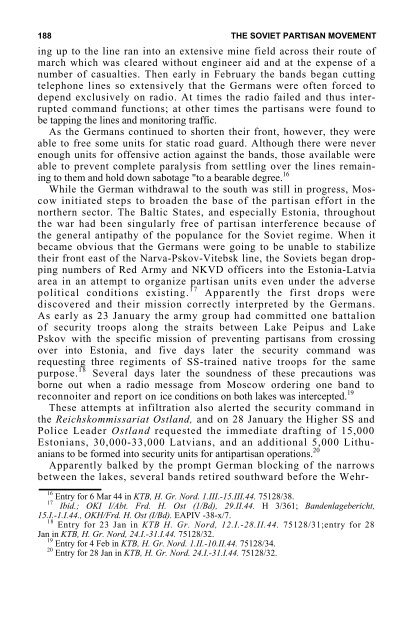the soviet partisan movement 1941-1944 by edgar m. howell
the soviet partisan movement 1941-1944 by edgar m. howell
the soviet partisan movement 1941-1944 by edgar m. howell
You also want an ePaper? Increase the reach of your titles
YUMPU automatically turns print PDFs into web optimized ePapers that Google loves.
188 THE SOVIET PARTISAN MOVEMENT<br />
ing up to <strong>the</strong> line ran into an extensive mine field across <strong>the</strong>ir route of<br />
march which was cleared without engineer aid and at <strong>the</strong> expense of a<br />
number of casualties. Then early in February <strong>the</strong> bands began cutting<br />
telephone lines so extensively that <strong>the</strong> Germans were often forced to<br />
depend exclusively on radio. At times <strong>the</strong> radio failed and thus interrupted<br />
command functions; at o<strong>the</strong>r times <strong>the</strong> <strong>partisan</strong>s were found to<br />
be tapping <strong>the</strong> lines and monitoring traffic.<br />
As <strong>the</strong> Germans continued to shorten <strong>the</strong>ir front, however, <strong>the</strong>y were<br />
able to free some units for static road guard. Although <strong>the</strong>re were never<br />
enough units for offensive action against <strong>the</strong> bands, those available were<br />
able to prevent complete paralysis from settling over <strong>the</strong> lines remaining<br />
to <strong>the</strong>m and hold down sabotage "to a bearable degree. 16<br />
While <strong>the</strong> German withdrawal to <strong>the</strong> south was still in progress, Moscow<br />
initiated steps to broaden <strong>the</strong> base of <strong>the</strong> <strong>partisan</strong> effort in <strong>the</strong><br />
nor<strong>the</strong>rn sector. The Baltic States, and especially Estonia, throughout<br />
<strong>the</strong> war had been singularly free of <strong>partisan</strong> interference because of<br />
<strong>the</strong> general antipathy of <strong>the</strong> populance for <strong>the</strong> Soviet regime. When it<br />
became obvious that <strong>the</strong> Germans were going to be unable to stabilize<br />
<strong>the</strong>ir front east of <strong>the</strong> Narva-Pskov-Vitebsk line, <strong>the</strong> Soviets began dropping<br />
numbers of Red Army and NKVD officers into <strong>the</strong> Estonia-Latvia<br />
area in an attempt to organize <strong>partisan</strong> units even under <strong>the</strong> adverse<br />
political conditions existing. 17 Apparently <strong>the</strong> first drops were<br />
discovered and <strong>the</strong>ir mission correctly interpreted <strong>by</strong> <strong>the</strong> Germans.<br />
As early as 23 January <strong>the</strong> army group had committed one battalion<br />
of security troops along <strong>the</strong> straits between Lake Peipus and Lake<br />
Pskov with <strong>the</strong> specific mission of preventing <strong>partisan</strong>s from crossing<br />
over into Estonia, and five days later <strong>the</strong> security command was<br />
requesting three regiments of SS-trained native troops for <strong>the</strong> same<br />
purpose. 18 Several days later <strong>the</strong> soundness of <strong>the</strong>se precautions was<br />
borne out when a radio message from Moscow ordering one band to<br />
reconnoiter and report on ice conditions on both lakes was intercepted. 19<br />
These attempts at infiltration also alerted <strong>the</strong> security command in<br />
<strong>the</strong> Reichskommissariat Ostland, and on 28 January <strong>the</strong> Higher SS and<br />
Police Leader Ostland requested <strong>the</strong> immediate drafting of 15,000<br />
Estonians, 30,000-33,000 Latvians, and an additional 5,000 Lithuanians<br />
to be formed into security units for anti<strong>partisan</strong> operations. 20<br />
Apparently balked <strong>by</strong> <strong>the</strong> prompt German blocking of <strong>the</strong> narrows<br />
between <strong>the</strong> lakes, several bands retired southward before <strong>the</strong> Wehr<br />
16 Entry for 6 Mar 44 in KTB, H. Gr. Nord. 1.III.-15.III.44. 75128/38.<br />
17<br />
Ibid.; OKI I/Abt. Frd. H. Ost (1/Bd), 29.II.44. H 3/361; Bandenlagebericht,<br />
15.I.-1.I.44., OKH/Frd. H. Ost (I/Bd). EAPIV -38-x/7.<br />
18 Entry for 23 Jan in KTB H. Gr. Nord, 12.I.-28.II.44. 75128/31;entry for 28<br />
Jan in KTB, H. Gr. Nord, 24.I.-31.I.44. 75128/32.<br />
19 Entry for 4 Feb in KTB, H. Gr. Nord. 1.II.-10.II.44. 75128/34.<br />
20 Entry for 28 Jan in KTB, H. Gr. Nord. 24.I.-31.I.44. 75128/32.
















